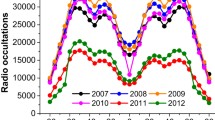Abstract—
Analysis of the temporal variations of the virtual heights of the sporadic E layer (hꞌES) determined from ionograms with increased accuracy (1 km) has revealed the following features of annual variations in the mid-latitudes of the Northern Hemisphere. It has been found that the intra-seasonal average values of hꞌES are higher in the winter than in summer. The range of intra-seasonal variations, which, along with noise, contain variations with periods from several days to several tens of days, is also larger in winter than in summer. It should be noted that the changes in seasonal modes occur rather quickly. This, as well as the increase in the amplitudes of variations with periods characteristic of planetary waves in winter, allows us to make an assumption about the connection of seasonal transitions in the behavior of hꞌES with the spring and autumn rearrangements of the circulation in the middle atmosphere. In order to verify this assumption, the results of rocket measurements of the zonal wind speed at 20–80-km altitudes above Volgograd (48°68′ N, 44°35′ E) are compared to the data from Poitiers ionospheric station (46°6′ N, 0°3′ E) in 1984–1989. It has been found that in 1984–1988 the timing of the spring change of seasonal modes of the behavior of hꞌES and the timing of the rearrangement of the stratomeasospheric circulation from west to east coincided, and the transition in the ionosphere slightly preceded the rearrangement in the middle atmosphere only in 1989. In autumn, the change in seasonal modes of the behavior of hꞌES in 1984–1989 was always delayed relative to the onset of the zonal wind reversal in the stratomesosphere by an almost fixed time interval of approximately 2 months.







Similar content being viewed by others
REFERENCES
J. D. Whitehead, “Formation of the sporadic E layer in the temperate zones,” Nature, No. 4750, 567 (1960).
J. D. Whitehead, “The formation of the sporadic E layer in temperate zones,” J. Atmos. Terr. Phys. 20, 49–58 (1961).
V. D. Kokourov, G. V. Vergasova, and E. S. Kazimirovsky, “Oscillations with planetary wave periods in variations in the ionospheric parameters over Eastern Siberia,” Geomagn. Aeron. (Engl. Transl.) 49 (7), 994–1001 (2009).
K. Karami, S. Ghader, A. A. Bidokhti, M. Joghataei, A. Neyestani, and A. Mohammadabadi, “Planetary and tidal wave-type oscillations in the ionospheric sporadic E layers over Tehran region,” J. Geophys. Res. 117, A04313 (2012). https://doi.org/10.1029/2011JA017466
A. Pignalberi, M. Pezzopane, and E. Zuccheretti, “A spectral study of the mid-latitude sporadic E layer characteristic oscillations comparable to those of the tidal and the planetary waves,” J. Atmos. Sol.-Terr. Phys. 122, 34–44 (2015).
Z. Mošna and P. Koucká Knižova, “Analysis of wave-like oscillations in parameters of sporadic E layer and neutral atmosphere,” J. Atmos. Sol.-Terr. Phys. 90–91, 172–178 (2012).
Z. Mošna, P. Koucká Knižova, and K. Potužníková, “Coherent structures in the Es layer and neutral middle atmosphere,” J. Atmos. Sol.-Terr. Phys. 136, 155–162 (2015).
J. G. Charney and P. G. Drazin, “Propagation of planetary-scale disturbances from the lower into the upper atmosphere,” J. Geophys. Res. 66 (1), 83–109 (1961).
URSI Handbook of Ionogram Interpretation and Reduction, Ed. by W. R. Piggot and K. Rawer (Ashville, NC, U.S. Department of Commerce, NOAA, 1972).
ftp://ftp.ngdc.noaa.gov/ionosonde/request/Ionospheric_Digital_Database_Data.zip.
Meteorology of the Upper Atmosphere of the Earth, Ed. by G. A. Kokin and S. S. Gaigerov (Gidrometeoizdat, Leningrad, 1981) [in Russian].
P. Bencze, “Seasonal variations of the virtual height of sporadic E(h’E S) at middle latitudes and its possible origin,” Pure Appl. Geophys. 75, 167–174 (1969).
F. Märcz and P. Bencze, “Changes in sporadic E parameters observed at Juliusruh during a period following solar activity maximum,” Acta Geod. Geophys. Hung. 39, 341–33354 (2004).
ACKNOWLEDGMENTS
The article is based on the oral report presented at the All-Russian Conference Intrinsic Radiation, Structure, and Dynamics of the Middle and Upper Atmosphere (Moscow, November 22–23, 2021).
Author information
Authors and Affiliations
Corresponding author
Ethics declarations
The authors declare that they have no conflicts of interest.
Additional information
Translated by O. Pismenov
The paper is based on an oral report presented at the All-Russian Conference “Intrinsic Radiation, Structure, and Dynamics of the Middle and Upper Atmosphere” (Moscow, November 22–23, 2021).
Rights and permissions
About this article
Cite this article
Kuminov, A.A. On the Relationship between the Characteristics of the Annual Variations of the Virtual Height of the Ionospheric Sporadic E Layer with the Seasonal Rearrangements of the Stratomesospheric Circulation. Izv. Atmos. Ocean. Phys. 58, 412–421 (2022). https://doi.org/10.1134/S0001433822040065
Received:
Revised:
Accepted:
Published:
Issue Date:
DOI: https://doi.org/10.1134/S0001433822040065




